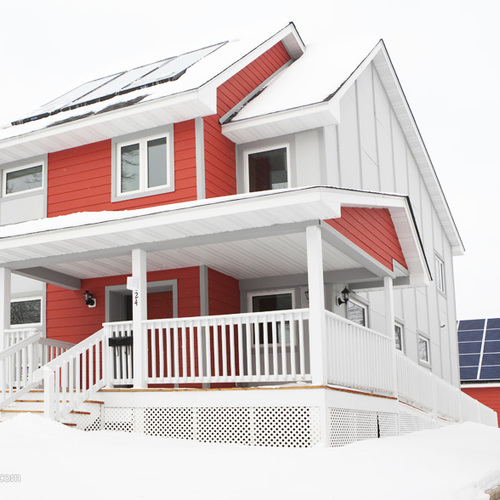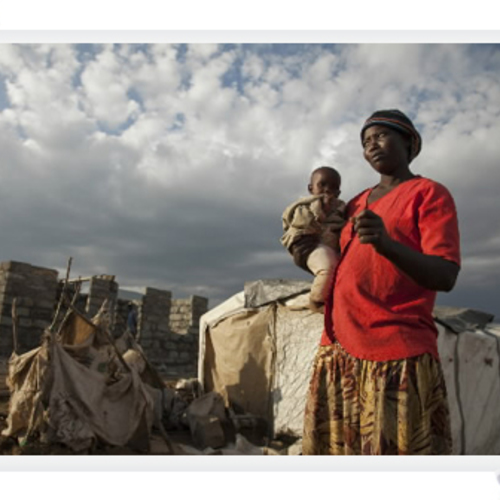Image Credit: Jim Cooper
Image Credit: Jim Cooper Work in progress: Habitat built three duplexes last year and hopes to complete another eight single-family houses on adjacent land this year.
Image Credit: Jim Cooper Houses have PV arrays of up to 6 kW and the community will have a 75 kW installation to provide both outdoor lighting and a source of revenue.
Image Credit: Jim Cooper Floor plans are open and houses have ample natural light inside.
Image Credit: Jim Cooper
An ambitious Habitat for Humanity project in River Falls, Wisconsin, is now in it second year of construction with three net-zero energy duplexes complete and another dozen housing units plus a community center still to come.
Eco Village, located about 35 miles east of Minneapolis, Minn., in a city of 15,000, is the work of St. Croix Valley Habitat for Humanity, the City of River Falls, the University of Wisconsin, Frisbie Architects, the St. Croix Institute for Sustainable Community Development, and a number of corporate and community partners.
Eco Village residents will have community produce gardens and common green spaces and walking trails. There are even plans for a small fleet of communal electric cars. Houses are designed to qualify for LEED-Platinum certification.
“Eco Village is a real-world illustration of the viability of sustainable design — not only in environmental terms, materials used or energy efficiency, but also as it applies to broader economic concerns, social impact, transportation, food, water and self-sufficiency,” Habitat says in a brochure describing the project.
Houses come in different sizes, but all are high-performance
Jim Farr, executive director of the local Habitat chapter, says houses have two, three, or four bedrooms, ranging in size from 800 sq. ft. to 1,200 sq. ft. They’re “modest” in size but because of open floor plans and large windows, they have plenty of natural light inside.
More to the point, the houses have tight envelopes with preliminary HERS ratings as low as 4 and blower door tests from 0.9 to 1.0 ach50. Among the features described by construction operations manager Jim Cooper:
- Horizontal under-slab insulation of 6 in. of XPS foam (R-30)
- Foundations made with insulating concrete forms (ICFs) with an 8-in. concrete core, 2 5/8 in. of EPS foam on each side, and an additional 4 in. of foam on the outside wall (R-30).
- Above-grade walls made with 12-in. thick structural insulated panels (SIPs) with an additional 1 in. of rigid foam on the outside (R-59). On the inside of the walls is a non-bearing 2×4 wall on 24-in. centers as a plumbing and wiring chase.
- Between 2 in. and 3 in. of closed-cell polyurethane foam on the top of the ceiling drywall, followed by 24 in. of blown-in cellulose and a layer of ground-up EPS scraps. Cooper estimates an R-value of at least 100.
- Sprinkler systems that reduce fire insurance costs.
- In slab-on-grade houses, a bathroom with 6-in. ICF walls to make it tornado safe room that meets FEMA specifications.
- In-floor radiant heat drawing on a combination of solar thermal and electric water heater sources, plus Fujitsu ductless minisplits chiefly for air conditioning.
- Zehnder heat recovery ventilators
- Rainwater barrels and underground cisterns for irrigation.
Houses have their own photovoltaic arrays, between 5 kW and 6 kW in capacity, plus solar thermal systems designed to provide about half of the domestic hot water demand. A separate 75 kW PV installation at one end of the property will provide power for community purposes, such as lighting, and will also produce revenue that can go toward additional construction, Farr says.
Big benefits for participating families
As many as eight single-family houses will be added in 2013, along with a 5,000-to-6,000-sq. ft. community center. The project, which should be completed by late 2014 or early 2015, “fit really well” with River Falls’ long-range plans for affordable housing, Farr says. The idea of building the community percolated for several years and eventually the city donated the “greyfield” land for the project. A long list of corporate and foundation donors contributed money, expertise, and building materials to make it possible.
Qualifying families make 25% to 60% of the median income in the area, between $25,000 and $50,000 per year, Farr says, and contribute 500 hours of “sweat equity,” typically on their own house or another house in the community, as their down payment. St. Croix Valley Habitat for Humanity holds the 30-year, 0% mortgages.
The many energy enhancements should save a family between $200 and $300 per month in utility bills when compared to a conventional home of the same size and $100,000 over the course of the 30-year mortgage, Farr says.
Habitat envisions a “holistic community”
In discussing the project, Farr returns repeatedly to the community nature of Eco-Village, not just its high-efficiency houses or PV arrays.
There was the decision not to plant the oak and maple trees you might in a typical development in the area, but an “edible landscape” of fruit trees. There will be four community gardens when the project is fully developed, as well as walking trails, and a community center that will be a “bridge to the community.”
The electric vehicles — between 4 and 6 vehicles — that Farr hopes to add will be available to Eco Village residents for errands, potentially reducing the number of vehicles in the average family from two to one. That will mean significant savings for the families while cutting the community’s carbon footprint, Farr says.
He added that since the project was launched, there has been a 69% increase in the number of volunteer hours donated to the local Habitat chapter, and a 59% jump in the number of volunteers. In all, hundreds of volunteers donated 16,000 hours of time to get the first part of the project complete.
Weekly Newsletter
Get building science and energy efficiency advice, plus special offers, in your inbox.
















2 Comments
Funny R-value math, or just a typo, or...?
With 2 layers of 2-5/8" EPS for 5.25" @ R4.2/inch it starts out R22, to which 4" of EPS @ R4.2/inch or R17 gets added, my math comes out at about R39 for the foam itself, give it another R1 for the concrete, maybe yet another R1 for the siding + gypsum and you're a hair north of R40.
...whereas the article is claiming a mere R30?
To hit R59 with a 12" SIP + an inch of exterior foam means that OSB skins included it would have to average (R59/13"=) R4.5 per inch, which isn't very likely with EPS core OSB skinned SIP, unless (illegitimately) using a 40F or colder R/inch spec for the EPS. It might perform that well during the peak-cold mid-winter months, but not through the winter or annual averages. (To hit a 40F average through the foam with a 70F interior implies a 10F AVERAGE outdoor temp, which is below the average mid-winter temps in that area.) If the SIPs are cored with Type II EPS and there is an inch of exterior poly iso, with allowances for OSB/gypsum/siding it's still coming up shy of R55, making ~R59 a 10% exaggeration, even before drilling down on the amount of thermal bridging there is on the bottom & top plates of the SIP, the window & door framing, etc. It's probably really sub R50-whole wall, with all factors taken into account, and not R59 (even for the clear-wall, no thermally bridging structural elements.)
Published specs on 12-1/4" SIPs typically run R45 clear-wall @ 75F, sometimes claiming R48 clear wall/R41 whole-wall @ (the aforementioned bogus) 40F, with typical window & door framing fractions. (eg: http://www.r-control.com/downloads/brochure/R-Control%20SIP.pdf or http://www.acmepanel.com/r-value-comparison.asp) You'd add at most R7 for the inch of exterior foam, and another ~R1 for the siding & gypsum for a not quite-honest R49, probably more like R45-R46 in reality. An ~R45 wall is a pretty good wall, but it's not an ~R60 wall, and it's something of a dis-service to claim that it is.
Any insight as to why they're going with 6" of (high global warming potential HFC blowing agents ) XPS under the slab, rather than 7" of (about 1/100th the lifecycle global warming potential) Type IX EPS, at the same R value & compressive strength?
I'm curious as to how a layer of ground up EPS scrap meets code on fire ratings, unless buried under the 24" of cellulose?
(I know, EVERYBODY is a critic, eh? :-) )
Dana Downer
Scott,
While I'm sure Dana's critique is valid, the real point seems to have been missed, and that is if Habtitat can do it, everyone can do it. Our local Habitat Building Committee meets next week to discuss whether to pursue a Passive House pilot project. While I will be advocating for the principle I'm not going to advocate for the protocols. I'm more than happy to get a HERS 4 with a tight house and good indoor air quality. Thanks for the article.
Log in or create an account to post a comment.
Sign up Log in